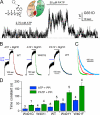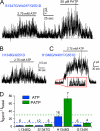Optimization of the degenerated interfacial ATP binding site improves the function of disease-related mutant cystic fibrosis transmembrane conductance regulator (CFTR) channels
- PMID: 20861014
- PMCID: PMC2988371
- DOI: 10.1074/jbc.M110.172817
Optimization of the degenerated interfacial ATP binding site improves the function of disease-related mutant cystic fibrosis transmembrane conductance regulator (CFTR) channels
Abstract
The cystic fibrosis transmembrane conductance regulator (CFTR) chloride channel, an ATP binding cassette (ABC) protein whose defects cause the deadly genetic disease cystic fibrosis (CF), encompasses two nucleotide binding domains (NBD1 and NBD2). Recent studies indicate that in the presence of ATP, the two NBDs coalesce into a dimer, trapping an ATP molecule in each of the two interfacial composite ATP binding sites (site 1 and site 2). Experimental evidence also suggests that CFTR gating is mainly controlled by ATP binding and hydrolysis in site 2, whereas site 1, which harbors several non-canonical substitutions in ATP-interacting motifs, is considered degenerated. The CF-associated mutation G551D, by introducing a bulky and negatively charged side chain into site 2, completely abolishes ATP-induced openings of CFTR. Here, we report a strategy to optimize site 1 for ATP binding by converting two amino acid residues to ABC consensus (i.e. H1348G) or more commonly seen residues in other ABC proteins (i.e. W401Y,W401F). Introducing either one or both of these mutations into G551D-CFTR confers ATP responsiveness for this disease-associated mutant channel. We further showed that the same maneuver also improved the function of WT-CFTR and the most common CF-associated ΔF508 channels, both of which rely on site 2 for gating control. Thus, our results demonstrated that the degenerated site 1 can be rebuilt to complement or support site 2 for CFTR function. Possible approaches for developing CFTR potentiators targeting site 1 will be discussed.
Figures





Similar articles
-
The most common cystic fibrosis-associated mutation destabilizes the dimeric state of the nucleotide-binding domains of CFTR.J Physiol. 2011 Jun 1;589(Pt 11):2719-31. doi: 10.1113/jphysiol.2010.202861. Epub 2011 Apr 11. J Physiol. 2011. PMID: 21486785 Free PMC article.
-
Mechanism of G551D-CFTR (cystic fibrosis transmembrane conductance regulator) potentiation by a high affinity ATP analog.J Biol Chem. 2008 Feb 29;283(9):5364-9. doi: 10.1074/jbc.M709417200. Epub 2007 Dec 30. J Biol Chem. 2008. PMID: 18167357
-
G551D and G1349D, two CF-associated mutations in the signature sequences of CFTR, exhibit distinct gating defects.J Gen Physiol. 2007 Apr;129(4):285-98. doi: 10.1085/jgp.200609667. Epub 2007 Mar 12. J Gen Physiol. 2007. PMID: 17353351 Free PMC article.
-
The gating of the CFTR channel.Cell Mol Life Sci. 2017 Jan;74(1):85-92. doi: 10.1007/s00018-016-2390-z. Epub 2016 Oct 1. Cell Mol Life Sci. 2017. PMID: 27696113 Free PMC article. Review.
-
Exploiting species differences to understand the CFTR Cl- channel.Biochem Soc Trans. 2015 Oct;43(5):975-82. doi: 10.1042/BST20150129. Biochem Soc Trans. 2015. PMID: 26517912 Review.
Cited by
-
The most common cystic fibrosis-associated mutation destabilizes the dimeric state of the nucleotide-binding domains of CFTR.J Physiol. 2011 Jun 1;589(Pt 11):2719-31. doi: 10.1113/jphysiol.2010.202861. Epub 2011 Apr 11. J Physiol. 2011. PMID: 21486785 Free PMC article.
-
Asymmetry of movements in CFTR's two ATP sites during pore opening serves their distinct functions.Elife. 2017 Sep 25;6:e29013. doi: 10.7554/eLife.29013. Elife. 2017. PMID: 28944753 Free PMC article.
-
A comprehensive review of genetics and genetic testing in azoospermia.Clinics (Sao Paulo). 2013;68 Suppl 1(Suppl 1):39-60. doi: 10.6061/clinics/2013(sup01)06. Clinics (Sao Paulo). 2013. PMID: 23503954 Free PMC article. Review.
-
Nonintegral stoichiometry in CFTR gating revealed by a pore-lining mutation.J Gen Physiol. 2012 Oct;140(4):347-59. doi: 10.1085/jgp.201210834. Epub 2012 Sep 10. J Gen Physiol. 2012. PMID: 22966014 Free PMC article.
-
Identification of a novel post-hydrolytic state in CFTR gating.J Gen Physiol. 2012 May;139(5):359-70. doi: 10.1085/jgp.201210789. Epub 2012 Apr 16. J Gen Physiol. 2012. PMID: 22508846 Free PMC article.
References
-
- Davidson A. L., Chen J. (2004) Annu. Rev. Biochem. 73, 241–268 - PubMed
-
- Oswald C., Holland I. B., Schmitt L. (2006) Naunyn Schmiedebergs Arch. Pharmacol. 372, 385–399 - PubMed
-
- Procko E., O'Mara M. L., Bennett W. F., Tieleman D. P., Gaudet R. (2009) FASEB J. 23, 1287–1302 - PubMed
-
- Riordan J. R., Rommens J. M., Kerem B., Alon N., Rozmahel R., Grzelczak Z., Zielenski J., Lok S., Plavsic N., Chou J. L., et al. (1989) Science 245, 1066–1073 - PubMed
-
- Chen T. Y., Hwang T. C. (2008) Physiol. Rev. 88, 351–387 - PubMed
Publication types
MeSH terms
Substances
Grants and funding
LinkOut - more resources
Full Text Sources
Medical

